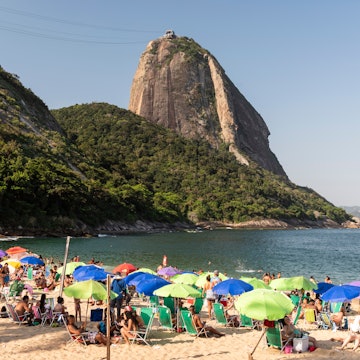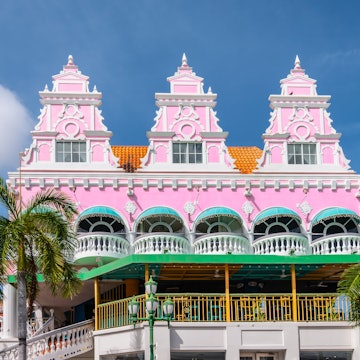
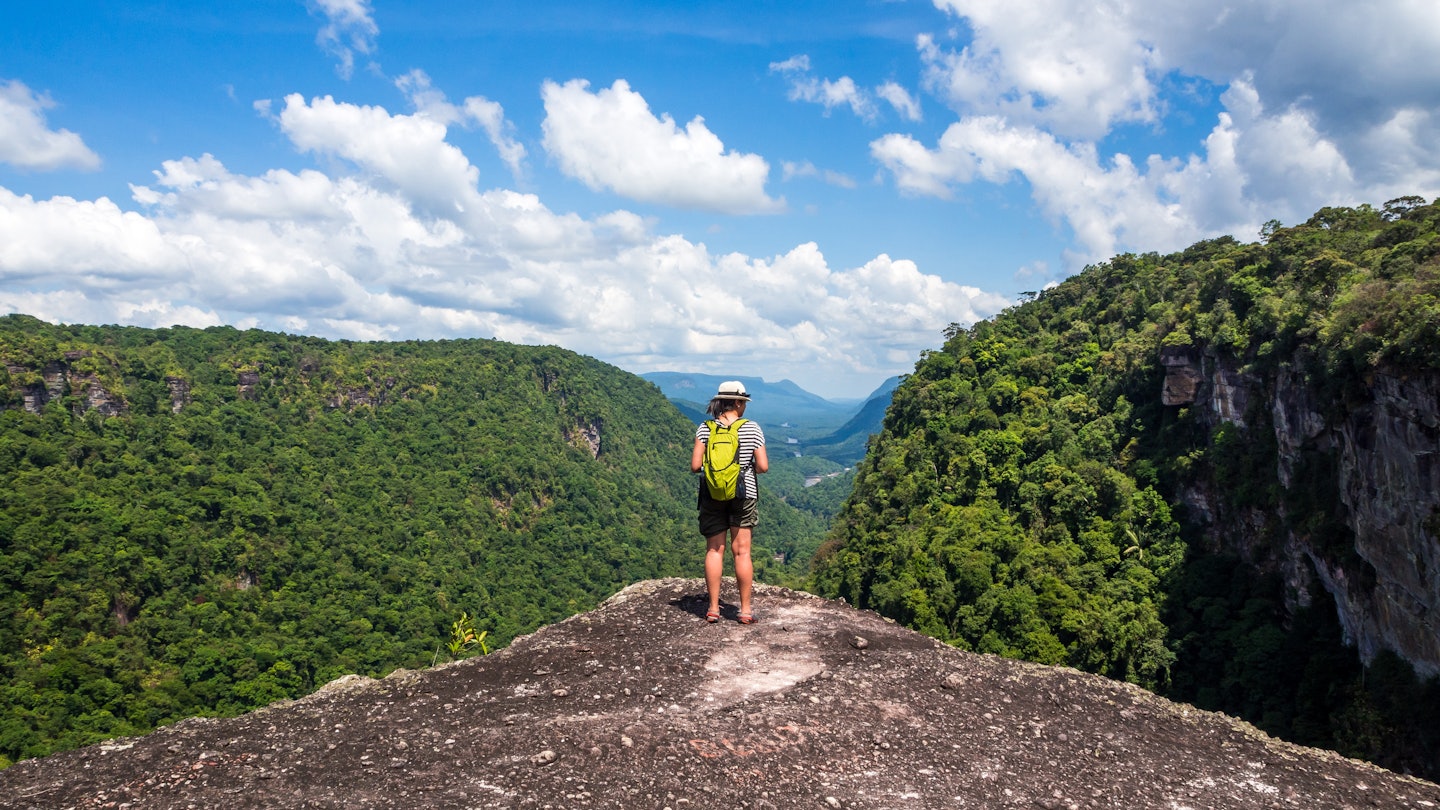
Guyana is off the main tourist radar: explore the wildlife-packed interior on a guided tour © Brandon Rosenblum / Getty Images
A multicultural, vibrant country teeming with rare wildlife, Guyana is yet little-known and little-visited. Even those who live there don’t tend to venture too far from the coast. Those who do make the effort to explore are met with one of the most untouched and majestic landscapes to be found, populated with bright rainforest birds and giant mammals, untrammeled trails and charming lodges. The relatively underdeveloped tourist infrastructure leads to both delightful adventure – as well as practical obstacles.
Consider a trip to Guyana if you want to go where few tourists have ventured; you love wildlife; you want to experience a mix of cultures; you find allure in rustic and roughing-it travel; and you have a yen for astonishing landscapes that haven’t changed in hundreds of years.
From the heat and humidity that hits you in the face as you land to the view of stars blanketing the sky above a boat on the Rupununi River, Guyana is a feast for the senses, and it is just waiting to be explored.
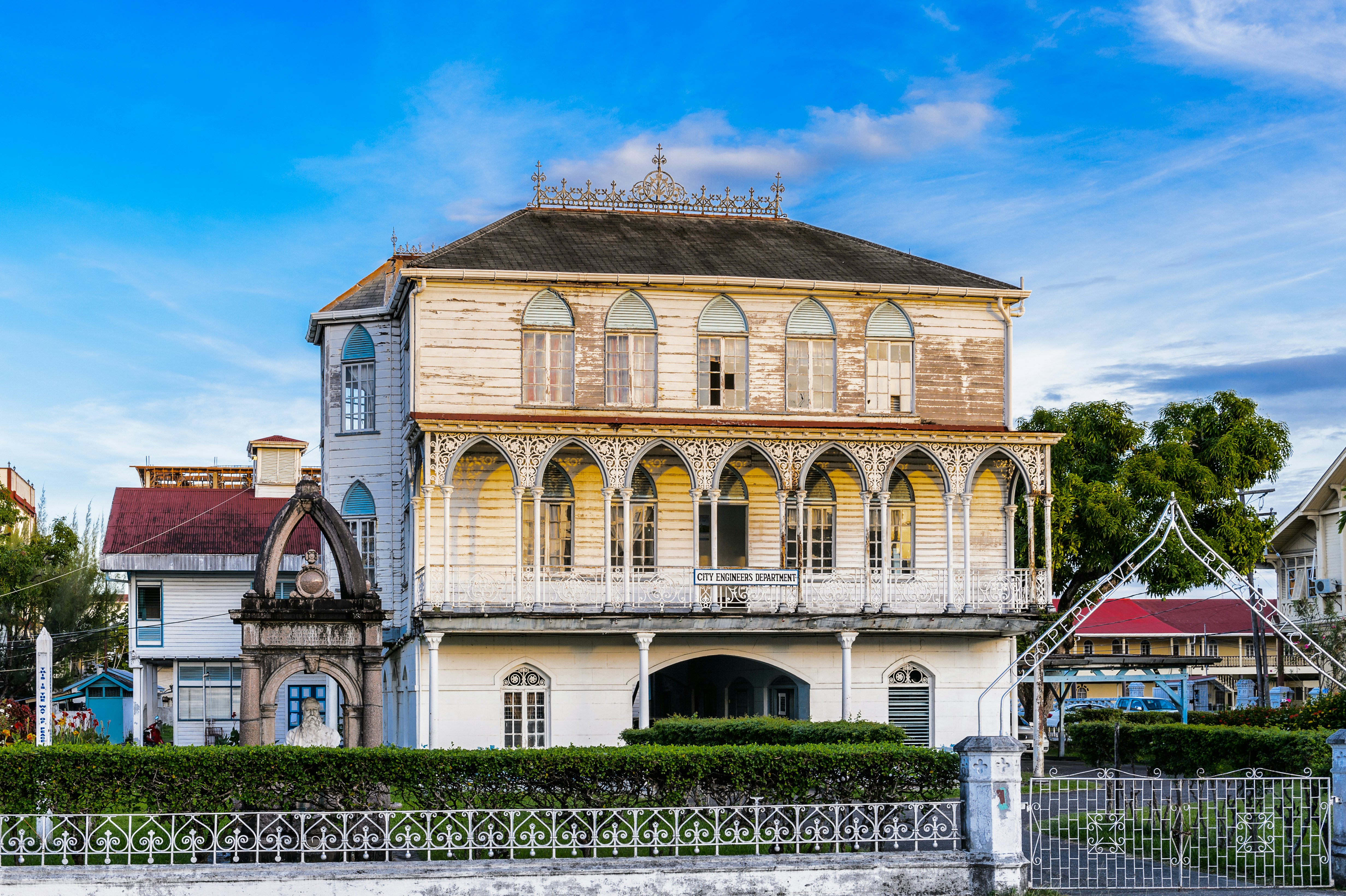
Is it easy to get in and around Guyana?
Flights to Guyana don’t run directly from many regions, but the number is increasing all the time. International flights usually land in Cheddi Jagan International Airport just outside Georgetown, Guyana’s capital and most populous city.
Flights to Cheddi Jagan run from the UK, the Caribbean, and various cities in northern, central and southern America. The border to Brazil can be crossed via taxi from Lethem, which will leave you in Bonfim. Lethem has a small airport for mainly domestic flights, or you can drive on the main road from Georgetown (roughly 550 kms). Access is not possible to Venezuela, where the border is disputed. There is also a ferry to Suriname that runs once a day, but it is busy and you will need to queue from early morning to get onboard.
Internally, travel isn’t seamless. The Georgetown to Lethem road is unpaved red clay, and currently takes 14 hours in a 4x4. There are plans for it to be paved, but the work is slow, and locals are not optimistic about it getting finished any time soon. When that road is paved, though, it will make domestic travel a lot easier. At the moment there is very little traffic on the road except during rodeo. Off this main road, you’ll be on rough, bumpy trails or traveling by river.
Domestic flights are by far the quickest way to get around the country, but they don’t run cheap. Trans Guyana Airways flies between Lethem and the Ogle airport in Georgetown once a day for USD$200 each way (at time of writing). Keep in mind, if you’re planning to take domestic flights, planes are small and weight limits are low. You will need to pack light. Considering these obstacles, the easiest way to get around Guyana is with a pre-booked itinerary.
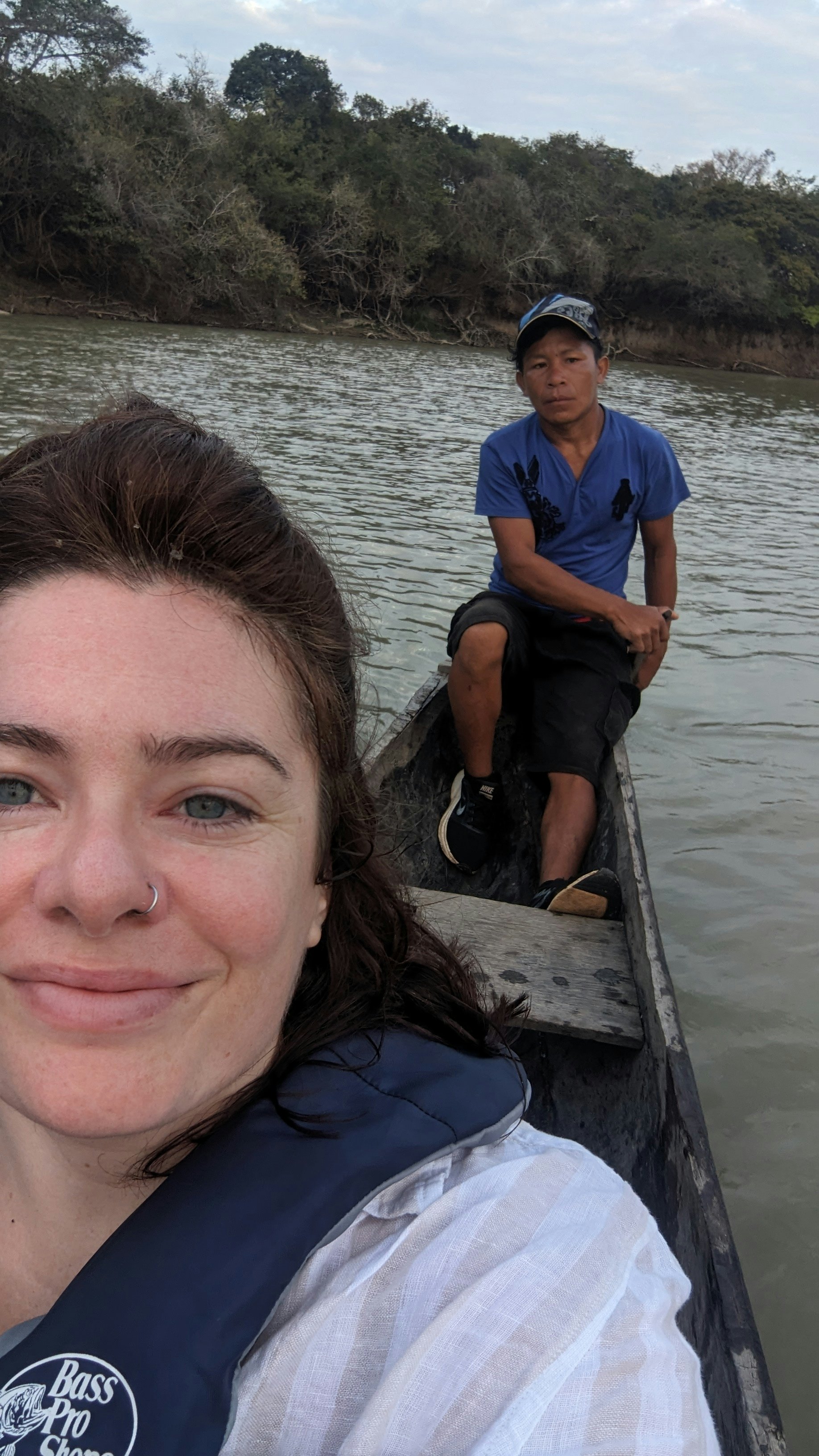
When is the best time to visit Guyana?
There are two types of season in Guyana: wet and dry. The coastal rainy season falls between mid-November and mid-January, while the second rainy season occurs between May and August and includes the country’s interior. Visitors planning to explore outside Georgetown will mainly want to avoid the second wet season: it becomes difficult to travel anywhere in the interior, and most accommodation will be closed.
Another major event in the Guyanese calendar that will affect travel is the annual Rupununi Rodeo in the southwest town of Lethem, in region 9. Visitors from the coast, neighboring Brazil, and local indigenous villages all gather for an Easter weekend of roping, ranching and bronco riding. There are also markets, pageants, and a host of other activities. It is estimated that at least 10,000 attendees gather for the event, and the road from Georgetown to Lethem gets busy. Lodging may also be hard to come by. So check the dates if you’re planning to travel to the southwest corner of Guyana in April or May.
How much time should I spend in Guyana?
Any visitor to Guyana will need to plan to take a lot of time – a long weekend is not going to cut it if you want to get outside Georgetown. With one main road, and a number of villages that are only accessible via river or plane, it can take time to travel in the interior. I would recommend not taking anything less than a week. The more time you give yourself the more time you can take to explore, experience the savannahs, rainforests and village life, and the more time you have to spot the wildlife.
Top things to do in Guyana

Visit the awe-inspiring Kaieteur Falls
Awesome in the true sense, Kaieteur Falls are probably the main draw for most visitors to Guyana. The largest single-drop waterfall in the world, it cascades over an arc of rainforest and flows through a valley engulfed in green.
On the flight into the park you are met with incredible views approaching the falls: broccoli-like forest canopies for hundreds of miles; there are no power lines, no roads, no sign of human presence whatsoever. If you’re lucky, your plane will take you around the falls for aerial views. A rainbow is formed over the fall which is viewable from – aptly named – Rainbow View, and the river flows into the gorge with a tree-covered valley rising on both sides. It’s a panorama so beautiful that it feels unreal. You can take a short hike to three or four different viewing spots, all of them Instagram-worthy.
It is difficult to reach Kaieteur National Park, in the Potaro-Siparuni Region of Guyana, where the falls are situated. Chartered flights, as part of a guided tour, are the easiest option, leaving from Ogle airport in Georgetown and coming back the same day. This lack of accessibility, while making it difficult for many to visit, means that the infrastructure surrounding the falls is low-key and doesn’t intrude on the natural features of the area. There’s a building for toilets, info, drinks and snacks, and otherwise it’s just you and the falls.

See rare species of wildlife
Guyana hosts a wide range of endemic, giant, colorful species, and any visitor would be remiss if they went home without making an effort to see some of them. The southern savannahs are home to giant otters, giant anteaters, iguanas, monkeys, and that’s before we even mention the birds: looking up at any point will grant you a view of a variety of herons, macaws, egrets, parakeets, hawks, kingfishers, swallows, and more. We were told that “every pond has a caiman”, and you will definitely see some of those if you venture anywhere near the Rupununi River.
These exotic species are in addition to the wildlife you’ll encounter during an average day: I had, at varying times, a bat in my bathroom, a possum staring at me across the sink as I brushed my teeth, a praying mantis land on my shoulder, and a massive beetle scare the life out of me as I sat reading in the evening. Lodgings even have a whistle, so that you can call for help should something more threatening wander in at night.
There are a number of tours you can take to view specific species in various environments, from birdwatching at sunrise to caiman tagging after sunset. The caiman tagging takes place at Caiman House in Yupukari Village on the Rupununi River. Caiman House is taking part in a long-term ecological research study that involves tagging, logging and releasing the black caiman of the river. The indigenous villagers of Yupukari are carrying out the research to enhance global knowledge of the species.
Karanambu Lodge will take you on a boat out to see giant lily pads on Buffalo Lake. These are the biggest lily pads in the world. There are 27 of these pads to a flower, which only bloom once the sun goes down. Watching the white flowers slowly open up as dusk sets in is an ethereal, otherworldly experience. You can also take trucks out at dawn to the savannah to look for the strange, lolloping giant anteater.
Atta Rainforest Lodge, further north, provides tours to look for the cock-of-the-rock, a gorgeous, bright orange bird endemic to Guyana. The cock-of-the-rock is found in the humid, lush rainforest. You can also visit the Iwokrama Canopy walkway here and experience the rainforest in all its glory.

My favorite thing to do in Guyana
Food is one of the many draws of Guyana. With its mix of cultures from China, India, Brazil, the Caribbean, and the local Amerindian population, Guyanese cuisine is an incredible fusion. Usually served in a communal buffet, there is perpetually delicious food to be had in the lodges: pepperpot, roti, okra, plantain, farinha (cassava meal), bakes, saltfish, cassava bread and vegetables. And always a refreshing jug of cold juice on hand.
One of the culinary highlights that you absolutely cannot miss in Georgetown (unless you’re unlucky enough to not be able to get a reservation – seriously, book this one well in advance) is the Backyard Cafe. The experience begins in Stabroek Market where restaurant owner and chef Delven takes you past stalls of colorful fruit, vegetables, pulses, fish, homeware, and everything else in between. It is lively and crowded, with vehicles constantly passing. Delven greets everyone, showcasing fruits, hot peppers and seasonal vegetables for sale.
A couple of hours later you then catch up with Delven at the Backyard Cafe – a relaxing, verdant oasis out the back of his mothers’ house in the suburbs of Georgetown. It is an absolute delight after the noise and chaos of Georgetown. An incredible selection of food is on offer using ingredients picked up at the market. There might be platters of bitter melon fries; egg balls (boiled egg in cassava batter – unreal); slices of yellow watermelon; boil-and-fry with plantains and okra; shark filets; chicken with fried rice; platters of mixed vegetables, pok choi (Chinese cabbage) and peppers and okra; farinha; chow mein; and more. It is a feast for all your senses: the eyes, the belly, and the nose.
Another excellent option for dining in Georgetown is the stylish Fresh: a gorgeous, spacious, chilled-out space that focuses on local ingredients from their own garden or local suppliers. The food here is inspired by the owners’ time in Toronto and around the globe. The food combinations throughout all courses are imaginative and, dare I say it, fresh. The meals are full of delicious flavors and combinations and textures.

How much money do I need for Guyana?
Guyana is not an expensive place to visit for food or accommodation. A three-star hotel in Georgetown is around USD$180 a night, and a meal for two in a mid-range restaurant is around USD$50. You can expect to pay from USD$100 to US$200 for one night in a lodge in the interior.
However when it comes to exploring the interior of the country, traveling between villages and taking guided tours, the prices increase significantly. Wilderness Explorers run tours from short city tours for USD$80 to two-week expeditions including wildlife and a variety of excursions. For a short trip to Kaieteur Falls from Georgetown you can expect to pay around USD$340. The tours will include all food, accommodation and transport, so they are definitely worth considering if you want to explore Guyana at any great length.
What should I pack for Guyana?
Be sure to bring bug spray, no matter where you are planning to stay. The bugs mean business around here, and mosquito nets can only do so much. Bring bite relief too, just in case. Pack light rain gear year-round. Rain can come on heavily – and without warning. You should also be ready for it to delay any plans you made. Roads can become impassable, and animals go into hiding.
Make sure you also get a SIM card – and visit an ATM for cash – before leaving Georgetown. Also be aware that most places won’t have the facility to take credit cards. There is not a lot of data coverage in the interior, and where there is wifi available, it can be expensive and time-dependent. Note: I found an eSim completely unworkable.
Amy Lynch traveled to Guyana at the invitation of CornerSun Destination Marketing. Lonely Planet staff members do not accept freebies in exchange for positive coverage.













